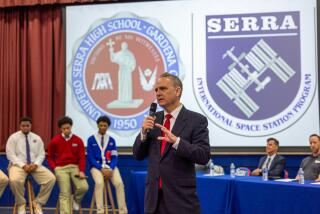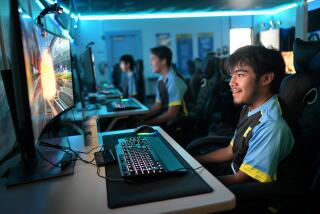MISSION VIEJO : High Hopes for Catapult Competition
Capistrano Valley High School students Robert McLendon and Ryan Waters had just two words for competitors Thursday as they put the finishing touches on their catapult contraption in Lyn Harvey’s science classroom: “ Extrapolate this !”
The two students are among 18 members of the campus’s year-old Future Scientists and Engineers of America club who will be competing Saturday in the first-ever regional catapult competition.
Capistrano Valley High, which will host the competition, was the first high school in the country to organize an FSEA chapter. Four other high school clubs in Orange and San Diego counties will participate in the competition.
In recent days, the Capistrano club members have been making last-minute design changes and test-firing tennis balls from their various catapults, most of which were designed and constructed during a 12-week period last fall.
“You just have to stay low in front,” said Waters as he tinkered with the trigger mechanism of his group’s catapult. “I duck just for insurance.”
While the main goal of the extracurricular science project is to generate enough force to catapult a tennis ball into a target 50 feet away, the students have learned much more than principles of math and physics.
“They’re also learning how to work in groups and how to compromise,” said Harvey, the club adviser. “They’ve had to learn lots of things.”
One of the toughest lessons has been in budgeting. The students are judged not only on the accuracy of the catapults, but also on how well they’ve stayed within a $40 design and construction budget. Club sponsor Southern California Gas Co. picked up the costs of the materials.
“In industry, if you’re doing a project and you go over budget, you’re going to get charged,” Harvey said.
But probably the biggest challenge for the students was to use mathematical equations to design the catapults.
“There’s just so many possibilities,” senior Brett Kelley said.
Senior Samir Shah and his fellow group members know that challenge well. In a trial competition within the club last year, the group won an award for the most creative catapult design. The problem was that the unwieldy catapult didn’t work so well in practice. They’ve since had to overhaul the design.
“It would have worked, but there were a lot of flaws,” Shah said. “We tried to make it more compact and more simplistic so there’s less that can go wrong. We don’t know how it will work, but we’ll be ready.”
The project is one of the first for the growing Future Scientists and Engineers of America Assn., which was formed last year by George Westrom, an engineer at an Anaheim-based robotics company. Harvey said she hopes the catapult competition will be an annual event.
“They’re learning science and math and putting it to work,” she said. “Sometimes on pencil and paper these things don’t translate well. But here’s a chance to do something and make it work.”
More to Read
Sign up for Essential California
The most important California stories and recommendations in your inbox every morning.
You may occasionally receive promotional content from the Los Angeles Times.










